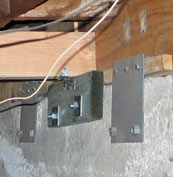by Shawn Kyles
 In Southern California, small earthquakes are common. But we also know that the next “big one” could happen at any time, and probably when we least expect it, leaving widespread destruction in its wake.
In Southern California, small earthquakes are common. But we also know that the next “big one” could happen at any time, and probably when we least expect it, leaving widespread destruction in its wake.
The last big Southern California quake was the Northridge Earthquake in January, 1994, which measured 6.7 on the Richter scale, and which caused 72 deaths, 9,000 injuries and $20 billion in damage. Whole apartment buildings and parking structures collapsed.
So what is an earthquake retrofit anyway, and how do you know if your home needs one?
An earthquake retrofitting is the process of firmly attaching a house to its concrete foundation using foundation plates and anchor bolts. Because California is "earthquake country," the up-and-down and side-to-side motion of an earthquake can shake an unbolted house off its foundation, making for a very costly repair job.
Here are some indicators that an earthquake retrofit is probably necessary for your home:
- Homes built before the mid 1980's often lack features that could help to make them earthquake damage resistant.
- Homes built before World War II may not even be bolted to the foundation at all, or the bolts may be too small and few. A major earthquake could slide such a house right off its foundation.
- An unreinforced garage with living space above is another possibly dangerous problem. That big garage door opening needs to be reinforced either by a steel frame or by strengthening the walls on either side or it can collapse in an earthquake like a house of cards, along with the living space on top.
- An unreinforced stone or masonry building definitely needs to be looked at, and is highly susceptible to earthquake damage.
These are some of the more obvious indicators. Here are some other conditions that could cause problems in an earthquake:
- Two or more stories
- Any support posts, instead of walls
- No foundation, or a block or brick foundation
- An unusual shape
- A location on a steep hill
- Living area over a garage
- A porch that is recessed under a second story
- A neighboring structure touching or almost touching.
The best thing to do is get a foundation inspection, which will include looking at the house bolting and seeing if it is adequate and if any other reinforcements are needed in your home. The inspection is usually free and the cost of any house bolting and reinforcements will usually be a lot less than moving your house back onto its foundation if an earthquake causes it to slide off.
No comments:
Post a Comment